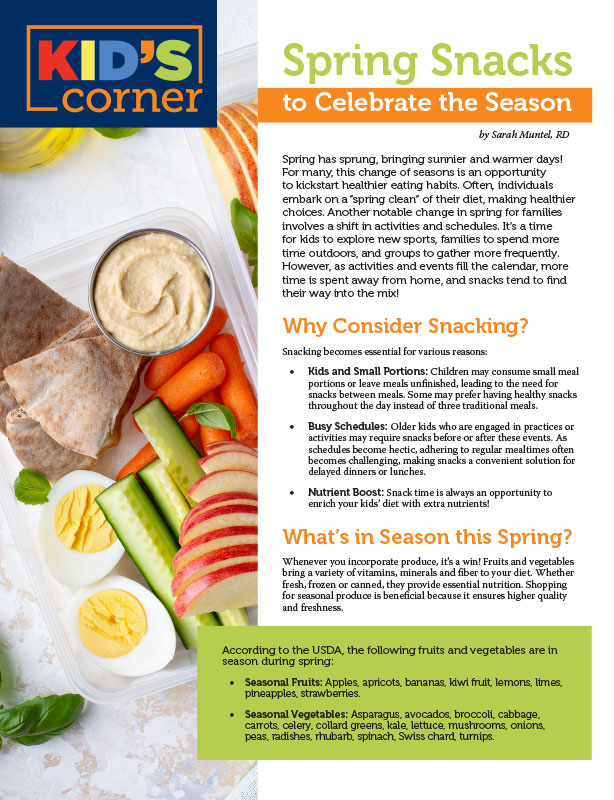Kid’s Corner: Picky Eaters No More!


by Amy Thul, RD, LD, CSOWM
Winter 2022
It’s dinner time and you’re running around the kitchen, trying to find something your child will eat. Some days, it seems the more you push food, the more they push back against what’s on their plate. The thought of going into battle at every meal or snack can be exhausting and stressful, but it doesn’t have to be this way. Mealtimes can be an enjoyable experience for both you and your child – a time for learning, bonding and even play!
Let Your Kids PICK What to Eat!
As children grow and their independence develops, some of the first decisions they can make are what they will or will not eat. You want your child to accept a variety of healthy foods, and when you are faced with a picky eater, it’s easy to feel as if you have few options to feed them.
The most important point surrounding meals is to remember that you can PICK and present the food options while your child makes the selection of WHAT to eat. This rule of thumb allows kids the freedom to choose what interests them at the time while you can rest assured that a balanced meal was presented. It’s exciting to see little ones grow up and make decisions for themselves, but this requires parents and caregivers to learn new approaches along the way.
Let’s not stop there! There are many additional strategies you can use so both parents and children are happy alike! Keep reading for more tips on mealtime behaviors.
Here are a few tidbits to remember:
- Be consistent with mealtimes and routines. Try to have meals and snacks around the same time each day.
- Keep the environment around mealtimes calm. A lot of distraction can pull your child’s attention away from what is on their plate. For example, turn down the volume on the television or turn it off. This puts more focus on the food itself.
- Be patient! A child can be offered a new food 10-15 times before they will try it.
- If your child protests the foods given at a meal, try the statement, “What you’re asking for is not on the menu tonight, but I do have these options for you.”
- Avoid filling up the plate. Having a lot of food on a plate can be distressing, but you can always provide more food if your child is still hungry. When introducing a new food, keep the portion size small. Try putting 3-4 blueberries out rather than filling up an entire section of their plate.
- Respect their level of hunger. Children can eat like a bird one day and chow down the next! Growth spurts and activity levels will play a factor in how much or how often a child eats. As long as your pediatrician gives the okay that they are still healthy and on track, let your child lead the way!
- Introduce one new food at a time. Having too many new choices can be overwhelming. This way, your child has some foods on their plate that are familiar.
- Lead by example! Children are always watching their biggest influencer, YOU! Reflect on your own willingness to try new foods and make healthy selections.
Developing a Child’s Relationship with Food
Kids are more curious about meals they participate in. This is a great time to develop a child’s relationship with food. Try one or all of these ideas to make meals more interactive:
Meal Plan
You may have a meal already designed in your mind. For example, a protein, a vegetable, a fruit and a starch are going on the table at lunch. Involve your child by presenting two choices of vegetables and have your child choose one to be served.
Buy Foods with Color
Make grocery shopping interactive! Find different vegetables and fruits of different colors. Try purple carrots instead of orange. Look for blue fruit, red vegetables or a yellow vegetable to spice up your child’s plate with some color.
Prep Your Food Together
Let your child participate in age-appropriate meal prepping and cooking. Children can sort through foods to be prepped or washed. Talk about the food and what you plan to do with it. What is the color? Does it have skin or a peel that needs to be removed? Will you slice or chop it? Will you cook it or eat it raw?
Shape it Up
Cookie cutters are no longer just for holidays. Break them out to make shapes out of sliced fruits or sandwiches. If you don’t want to create an art piece out of every meal, try presenting foods in a different way. For example, you can cut carrots or celery into sticks for dipping or slice up an apple instead of presenting it to them whole. Different shapes can make new foods less intimidating and more fun to eat.
Cover All of the Textures
Soft, crunchy, chewy…kids have preferences too! Serve foods with different textures at meal and snack times. Are the vegetables overcooked or mushy? Try roasting them in the oven or putting them in an air fryer to give them a tasty crunch!
Easy Steps to Success
While dealing with a picky eater can be challenging, there are easy, simple steps that any parent or caregiver can take to ensure their child is receiving the right nutrients at every meal. Just remember, healthy food can be fun and delicious too!
About the Author:
Amy Thul, RD, LD, CSOWM, is a Registered Dietitian in the metro Nashville area. She is a certified specialist in obesity and weight management who is also pursuing credentialing for functional nutrition to address health at the root cause. In her free time, she enjoys the outdoors with her dog Emma.
by Sarah Muntel, RD Spring 2024 Spring has sprung, bringing sunnier and warmer days! For many, this…
Read Articleby Robyn Pashby, PhD Winter 2024 “No one is ever going to date you if you don’t…
Read Articleby Michelle “Shelly” Vicari Winter 2024 Winter has arrived! Don’t allow the chilly and damp weather to…
Read Article









